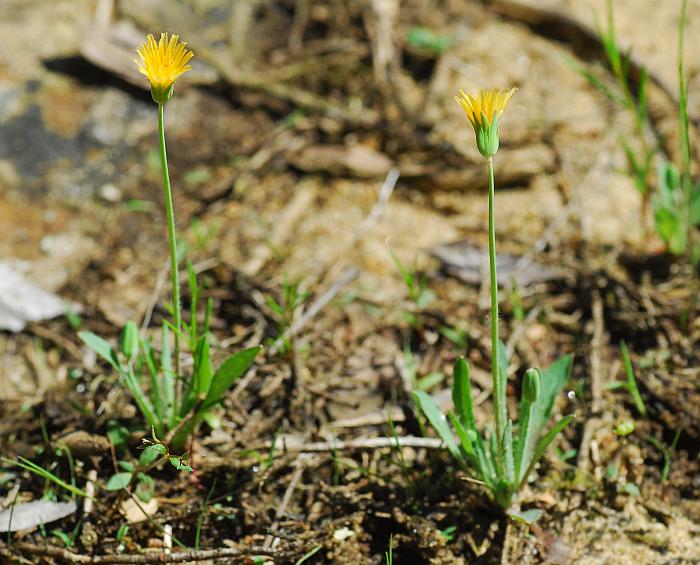Krigia virginica (L.) Willd.
Virginia Dwarf Dandelion

Native
CC = 3
CW = 5
MOC = 42
© SRTurner
Krigia virginica (L.) Willd.Virginia Dwarf Dandelion | |
 |
Native CC = 3 CW = 5 MOC = 42 |
© SRTurner |
|
Family - Asteraceae/Cichorieae Habit - Fibrous-rooted annual forb.
Stems - Typically single, erect, to 35 cm, sparsely to moderately pubescent with spreading, gland-tipped hairs, especially toward the tip. Leaves - Basal, or 1-4 toward the stem base from a rare late-season growth form, sessile or with an often winged petiole. Leaf blades 0.4-18.0 cm long, linear to lanceolate, oblanceolate or broadly ovate to broadly obovate, entire, toothed, or shallowly to deeply pinnately lobed, the teeth or lobes broadly triangular and pointed, the leaf tip rounded to sharply pointed, the surfaces glabrous or the undersurface (and margins), particularly near the base, sometimes sparsely pubescent with short, spreading hairs, these often gland-tipped, sometimes glaucous.
Heads - Ligulate. Involucral bracts 8-14, 4-7 mm long, narrowly lanceolate to narrowly oblong-lanceolate, not keeled, glabrous, withering and becoming reflexed with age. Ligulate florets 14-35. Corollas 4-12 mm long, yellow to less commonly yellowish orange, the ligules with 5 teeth at the tips. Pappus of 5 bristles and 5 short, inconspicuous scales, the bristles 4-6 mm long, white or nearly so to very light tan or pale straw-colored, the scales 0.5-1.0 mm long, broadly oblong with an irregularly truncate to bluntly angled tip, transluscent, white to light brown (especially toward the base).
Fruits - Achenes 1.5-2.2 mm long, somewhat obconical, 4- or 5-angled in cross-section, with 15-18 blunt ribs, these microscopically roughened or barbed, reddish brown to dark brown.
Flowering - April - August. Habitat - Glades, upland prairies, sand prairies, bluffs, ledges, fields, open disturbed areas, often on acidic substrates. Origin - Native to the U.S. Lookalikes - Krigia occidentalis, Krigia cespitosa; more broadly, several other members of the Cichorieae tribe of the Asteraceae, including other species in the Krigia genus. Other info. - Other info. - This little species can be found mainly in the southern half of Missouri, and also across most of the eastern half of the continental U.S. and parts of Canada. It can be recognized by its overall small stature and small but bright dandelion-like flowering heads. The two lookalikes which are closest in appearance, K. cespitosa and K. occidentalis, both lack the 5 long pappus bristles present on the florets and fruits of K. virginica. These, as well as the pappus scales, are clearly visible in the fruit photo above. Another potential lookalike is K. dandelion, but this species has larger flower heads, more bristles and scales making up the pappus, and potato-like tubers on the roots. Photographs taken in Brown Summit, NC., 4-19-02, 5-2-02, and 4-5-03 (DETenaglia); also near Silver Mines Recreational Area, Madison County, MO, 4-23-2012, Hughes Mountain Conservation Area, Washington County, MO, 5-14-2012, Don Robinson State Park, Jefferson County, MO, 4-26-2019, and Sand Prairie Conservation Area, Scott County, MO, 5-6-2020 (SRTurner). |